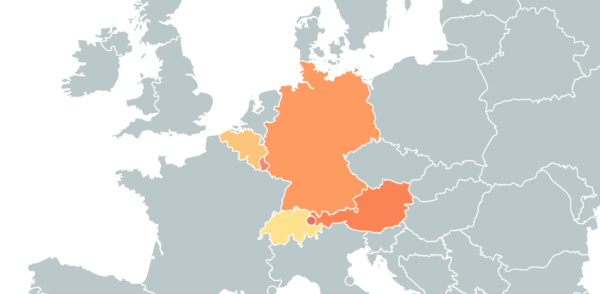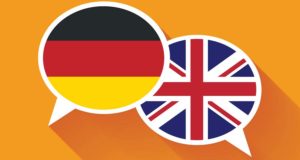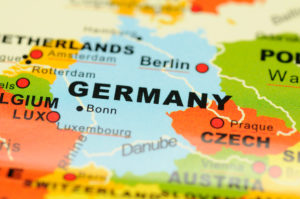What’s The Best Way to Learn German?
If you’re eager to learn German or just curious about it, then you need to build a solid foundation of the language. German is a beautiful language with a rich and fascinating history. And this guide will cover everything you need to know about German to get you started. After all, the best way to learn German is to understand its origins and how it transformed into the language it is today.
How Widely Spoken Is German?
German is the 11th most widely spoken language in the world today with over 95 million native speakers around the world and another 10 – 15 million who speak it as a second language. The majority of its speakers live in Europe, where it is the first language of 16 percent speaking of the population.
But German isn’t limited to Germany. It’s either the official or one of the official languages of Austria, Belgium, Liechtenstein, South Tyrol in Italy, and Switzerland. And it’s also one of the most studied languages in the world. Currently, around 14.5 million students are studying it with another 75 – 100 million students who’ve already studied it.

Where Does the Term “Deutsch” Come From?
The name Germany and its language, German, have a complicated history. While other countries in the region have a variety of names for the region, its people, and its languages, the Germans preferred the term Deutschland.
This comes from an adjective originating the Proto-Germanic *theudisk- which itself is derived from the Old High German thiota, diota (Proto-Germanic *theudō) meaning “people” or “folk”. So, in short, “Deutsch” means the language of the folk or people living in the Deutschland. And it was also originally used to describe the popular language in the region that was far different from the Latin used by religious and secular leaders in the area.
5 Interesting Facts about the German Language
One of the best ways to learn German is to dive into its curiosities. German is a unique language with many distinct differences that will stand out to native English speakers trying to learn the language. Here are a few examples:
- German nouns are capitalized.
- There are three genders: masculine, feminine, and neuter. (This differs from English with no genders and romance languages that only have Masculine and Feminine). Tip: Memorize the gender with the noun from the start.
- German is roughly 60 percent similar to English.
- Denglish is increasingly popular. These are German-English hybrid words such as “die Aircondition” for air conditioning or “der McJob” for a low paying job.
- German often has large compound words (the longest being 63 letters long): “Rindfleischetikettierungs – überwachungsaufgabenüber – tragungsgesetz” (“law for the delegation of monitoring beef labeling.”

How German Developed into the Language It Is Today
The version of German that exists today isn’t the one that’s always existed. Today, we have “Standard German”, a term used to describe the common language taught throughout the country. But given the long history of the German language, this is only a relatively recent development.
As mentioned before, German has origins as a Proto-Germanic language, a language spoken around 500 BCE with likely origins in Scandinavia. And like with all languages, geography, distance, and time played its role in separating variations of this language. As a result, by the 8th century CE, these languages were mostly unintelligible.
High Germanic Sound Sound Shift
Then the language experienced another significant change known as the High Germanic Sound Sound Shift (or High Germanic Consonant Shift). During this shift, several distinct changes in the language happened in two regions, the high region in southern Germany and the low region in northern Germany.
As a result, two distinct dialects were formed. Known as High and Low German, these dialects reflect the geographical region and are not a reflection of status. More on these two in a moment…
The High Germanic Consonant Shift happened in 3 out of 4 phases (the forth mostly impacted Dutch and low German). And the shift most likely occurred between the 3rd and 5th centuries AD. Here is each phase and what changes occurred:
1st Phase |
Example |
2nd Phase |
Example |
3rd Phase |
Example |
p→ff or final f |
English: sleep
German: schlafen |
p→pf (also spelled <ph> in OHG; after a liquid this later became f) |
English: apple
German: Apfel |
b→p |
Restricted to Swiss/Austrian/Bravarian German |
t→zz (later German ss) or final z (s) |
English: street
|
t→tz (in Modern German often spelled <z> and pronounced /ts/) |
English: cat
German: Katze |
d→t |
English: red
German: rot |
k→hh (later German ch) |
English: rich
German: reich |
k→kch (pronounced /kx/). |
English: to lick
German: lecken |
g→k |
Restricted to Swiss/Austrian/Bravarian German |
As you can see, some of these changes aren’t present in Standard German today, but still affected the language at the time. And because these language distinctions grew slowly over time, there are some areas where dialects of German are unintelligible to Standard German speakers. (These dialects are mostly fading out in favor of Standard German by younger generations).

What Is the Standard German Language?
In countries with several variations of a language, there is often an attempt to unify the region through a standard version of the native tongue. You see this in Spanish and Chinese, for example. In German, it’s known as Hochdeutsch or “High German”.
Hochdeutsch originally began as an attempt to create a common literary language throughout the country. The hope was that there would be one common version of the language that could be easily read throughout the region. This process (which lasted hundreds of years) began with Martin Luther’s efforts to translate the bible into German in 1522.
How Martin Luther Unified the German Language
As a result of his efforts to write a “living German”, Martin Luther created a version of the New Testament that was blended between his own Eastern Central German from Saxony and a few other dialects of High German.
Thanks to the printing press, many native speakers of German quickly ended up with a copy of Luther’s bible, helping unify the language. Regarding pronunciation, Martin Luther chose a dialect from Hanover. This resulted in losing some of the shifts in the language brought on by the High German Consonant Shift.
Additionally, as the language became the written language of the country, it eventually became the educational language spoken in the country as well. And over time, this resulted in it becoming the formal spoken language of Germany.
As a result, nearly all Germans can speak Standard German. True, some regions like Bavaria still have their own distinct dialect, but they’re still able to understand Standard German.
What Other Dialects of German Exist?
As noted, High German seemed to survive the tests of time, but that doesn’t mean that Low German and its influences faded completely. The influence of Low German can still be found in the northern part of Germany and parts of the Netherlands and Belgium.
And the same is true for distinct parts of High German which have influenced Northern Switzerland and Austria’s language today. This makes German a Pluricentric language or a language with multiple standard varieties.
Bavarian German (Bayerisch)
Situated in Southeastern Germany, this dialect of German differs mainly in vowel pronunciation. However, these distinct differences are sharp enough to confuse native speakers and make communication difficult.

Swiss German (Schwiizerdütsch)
One of the many main languages in Switzerland, it is usually limited to the German-speaking region of Switzerland. The pronunciation is noticeably different than Standard German. As a result, native speakers struggle with understanding it.
Austrian German (Österreichisches Deutsch)
While very similar to German and mutually intelligible, the pronunciation is distinct and noticeably different from Standard German. Germans and Austrians are able to easily notice the difference in speech patterns.
Upper Saxon Dialect (Sächsisch)
Säschsisch is primarily spoken in the east of Germany and is considered one of the Eastern Branches of Central German. While it is linguistically similar to Standard German, many German speakers are quick to point out the sharp differences in accents. (Similar to UK and US variations of English).
What Are the Differences Between English and German?
A good starting point for understanding German is to compare it to English. Seeing how it is both similar and different can help give you a better scope of what to expect and how much time it will take to gain fluency in the language. So far, we’ve touched on a few unique characteristics of German already. But, here are a few more that are in sharp contrast to English.
- Articles change: Articles in English are pretty straightforward (the dog, for instance). But in German, they change depending on the function of a noun in the sentence.
- There are no silent letters: This makes spelling easy as you don’t have to worry about silent letters, but it can make pronunciation hard because there are unique letter combinations that create sounds that don’t exist in English.
- Letters have sound limits: You don’t need to learn to pronounce all the variations of A/E/I/O/U, etc. Instead, you’ve got to learn an additional 3 vowels with umlauts and several letter combinations that make certain sounds. And that’s it.
- The verb for “to have” can express a feeling: In English, we have the “to be” verbs (I am, for instance) to express a state of being. German sometimes uses the possessive form of “to have” to express this instead. So, you would say, “I have hunger” in German rather than “I am hungry.”
- The verb is always second: Unlike English that allows you to mix up word order more, in German, the verb you conjugate is always second in the sentence. For instance, you’d say, “I went today swimming.”
And of course, because German is its own unique language with many variations of expression, these are far from all the differences from English. As you begin to study using the best way to learn German, you’ll pick up more. But if you’re interested, you can find several more differences here.

How Hard Is It to Learn the German Language?
Despite its similarities to English, the Foreign Service Institute (FSI) ranks Germany as a Category 2 language. For reference, the Romance languages are all classified as Category 1. This means they take roughly 575 – 600 hours to learn according to the FSI. Germany (the only category 2 language) requires around 750 hours to learn. Take these time-frames with a grain of salt, however, because how long it takes someone to learn a foreign language can vary greatly.
Common Mistakes German Language Learners Make
If you’re looking for the best way to learn German, then you need to watch out for mistakes. Most of these center around grammar. But anyone learning German can save themselves a lot of time and embarrassment by watching out for avoiding these common errors language learners make:
- False cognates (False Friends): A false cognate is when a word looks like an English word but has a completely different meaning. “Gift”, for instance, means “poison”.
- Incorrect use of genders and definitive articles (der, die, das): Gender matters in German. You need to match the right article to the right word from the beginning or you’ll confuse native speakers. An example: Die Katze ist weiß (The cat is white) vs. Der Katze ist weiß (incorrect).
- Using the wrong plural form: Unlike English, you need more than an -s/-es to make something plural. For example, Bruder is one brother, but Brüder means brothers.
- Not using reflexive pronouns: Many German words need a reflexive pronoun to communicate exactly what you need. Ich bin gut (I am good) is not the same as mir geht es gut (I’m doing fine). The first is cocky and grammatically incorrect, the other isn’t.
- Incorrect sentence order: Verbs and subjects can be at different parts of the sentence. Ich mag machen das. (I like to do that – Incorrect) vs. Ich mag das machen. (I like that to do – Correct). It’s best to learn the German sentence order to avoid confusion.
Words That Don’t Translate into English
German provides some uniquely German words that simply do not have an English translation. They are concepts people get or feelings they have expressed clearly in one word.
Here are a few examples of untranslateable German words:
- Schadenfreude: experiencing joy at someone else’s pain, suffering, or bad happening. If someone cuts you off on the highway, but then is pulled over by a police car for speeding, you may smile as you drive past. This is Schadenfreude.
- Doppelgänger: Based on the concept that there is a spirit or ghost of you in this world, a doppelgänger describes someone who looks very similar to you. A twin, but not a twin.
- Wanderlust: Someone who wants to travel or travels frequently. It’s the drive to travel and explore the world, to leave your home and find somewhere new.
You’ll find plenty more here if you’re interested.
You Can Learn German Easily
If this post proved anything, it’s that German is an awesome language. We can’t blame you if you want to give learning German a go. So, if you want to learn German in a fun and effective way, you need to download OptiLingo.
OptiLingo is an app that gets you to fluency fast. It only shows you the most important German words and phrases, so you don’t waste time on boring and unnecessary vocabulary. You’ll learn to speak German exactly like the locals do. Achieve successful German fluency when you download OptiLingo!








